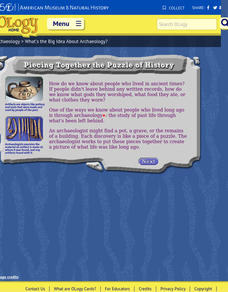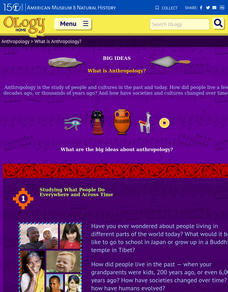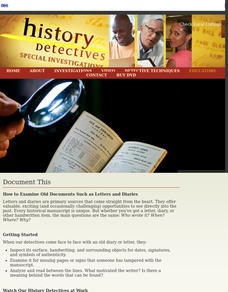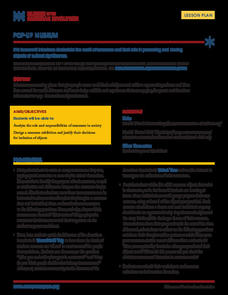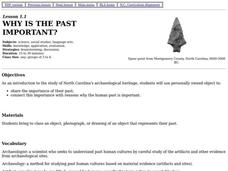Curated OER
No Title
Students explore and analyze various Roman artifacts to assess how they survived over time, their organic materials, categories and images. They evaluate Roman, silver, and bronze coinage for their emperor's titles and depict mythical...
Curated OER
Crystal Blue Persuasion
Students examine historic posters, jewelry, quilts and buttons that were created to protest or call attention to a political issue. After evaluating how these items were used to communicate a political message, students create an item...
Curated OER
People of the Stone Age: Hunters and Gatherers
Intended for a young audience, this presentation provides a simplistic view of the life of a Stone Age hunter/gatherer. Human migration, gathering, tools, and the Ice Age are covered but not in-depth. A topical discussion with good...
Curated OER
Features of Culture
In this culture worksheet, students examine thirty features of culture, then write one example for each that is common to people in the United States.
Henry Ford Museum
You Can Be an Innovator ... Like Henry Ford
Why did Henry Ford want to invent a car for the masses? Why did Henry Ford locate his factory in Detroit? Why did Henry Ford encourage the idea of a 5-day work week? Young innovators find the answers to these and other question in a unit...
American Museum of Natural History
What's the Big Idea About Archeology
The American Museum of Natural History offers a website sure to engage young anthropologists. Learners can dig into a site that offers an explanation of the field of archaeology, the kinds of questions archaeologists ask that launch...
American Museum of Natural History
What's This?: Early Humans
Early humans crafted shelters out of whatever materials they could find. A one-question quiz asks learners to identify the type of bones used to construct the hut pictured in a display.
American Museum of Natural History
What is Anthropology
A colorful resource introduces learners to the four major fields of anthropology: cultural anthropology, linguistic anthropology, biological anthropology, and archaeology. Explanations are provided for what each field studies, the kinds...
American Museum of Natural History
Make Your Own Mythic Mask or Puppet
No need to wait until Halloween to create a mask. Young anthropologists get involved in the centuries-old tradition of mask and puppet making with the help of an engaging resource that shows them how to craft their own masks or puppets.
PBS
Document This
Being a historian requires serious sleuthing. They examine primary source documents and look for evidence, for clues that reveal who wrote the document, when, and why. After watching two historians model the process, young history...
Channel Islands Film
Cache: Lesson Plan 3 - Grades 4-5
Should the excavation of what is believed to be the cave of the Lone Woman of San Nicholas Island be allowed to continue? As a practice exercise designed to prepare pupils for a timed writing exam, individuals read two Los Angeles...
Channel Islands Film
Once Upon a Time (Sa Hi Pa Ca): Lesson Plan 3
What was the most significant tool used by the Chumash? How did the environment make the tool possible? What group behaviors allowed the Chumash be be successful for thousands of years? After watching West of the West's documentary Once...
US House of Representatives
A Picture is Worth a Thousand Words
Groups select a photograph from one of the four eras of African Americans in Congress and develop a five-minute presentation that provides background information about the image as well as its historical significance. The class compares...
Museum of the American Revolution
Pop-Up Museum
Museums offer more than interesting exhibits—they are key to keeping history alive. An immersive activity uses a virtual field trip to show academics the importance of museums in preserving history. Young historians learn how museums are...
Angel Island Immigration Station Foundation
How Do Pictures Tell the Story of Angel Island?
Young historians learn more about the history of Angel Island Immigration Station through their analysis of primary source images. Guided by a list of inferential questions, scholars learn how to make and record observations on a...
Penguin Books
Educator's Guide: The Da Vinci Code by Dan Brown
Dan Brown's The Da Vinci Code is filled with secrets. Help readers find the clues, solve the riddles and puzzles, and unwrap the mysteries with a six-page guide that includes before, during, and after reading discussion questions and...
Facing History and Ourselves
Frame a Special Item
If you could frame something important to you, what would it be, where would you hang it, and why would you choose this particular thing to frame? These questions launch a lesson designed to help class members get to know each other....
Curated OER
"how To Think Like an Archaeologist" Suggested Pre-visit Activity for Historic Jamestowne
Young scholars study grocery receipts to simulate the archaeological activity of classifying items. They discuss the receipts as if they were find lists.
Curated OER
Why is the Past Important?
Fourth graders discuss the importance of North Carolina's archaeological heritage. They share with the class an object, photograph, or drawing of an object that represents their own or their family's past.
Curated OER
How Do We Learn About the Past?
Sixth graders discuss the role of an archaeologist as a class. After viewing photographs, they relate the objects found in their local area and Ancient Egypt. They draw a picture of an object that represents their own culture and gives...
Curated OER
Site Robbers
Fourth graders interview a Native American and write a newspaper article or letter that expresses concern about robbing archaeological sites.
Curated OER
Shoebox Dig
Students participate in a simulation in which they dig for artifacts in a shoebox filled with objects. In groups, they record the types of material and artifacts found in each layer. To end the instructional activity, they answer...
Curated OER
Thinking About the Past
Fourth graders use a personal item to understand and share the importance of their past. They connect this importance with reasons why all human past is important and recognize the sequence of change in Utah over time. They bring to...
Curated OER
Four Ancient River Civilizations
Students explore how the environment shapes man, how man transformed his world, nd how art became part of the human process. The group is divided into clans and their migratory routes developed in the eight lessons of this unit.
Other popular searches
- Inca Artifacts
- Cultural Artifacts
- Archeology Artifacts
- Indian Artifacts
- Artifacts and Archeology
- Native American Artifacts
- Historical Artifacts
- Ancient Cultures Artifacts
- American Artifacts
- Artifact Protection
- Artifact Classification
- Ancient Chinese Artifacts





